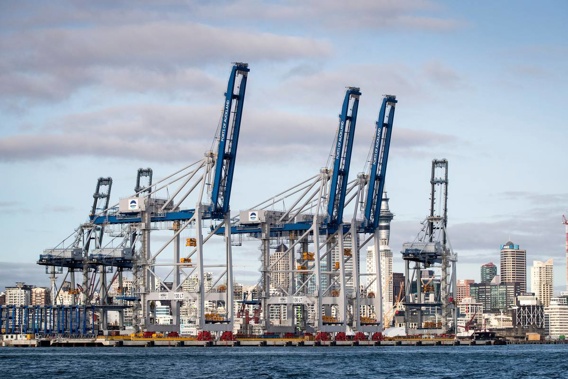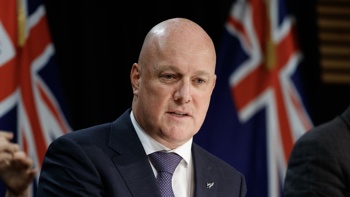
A high-powered working group has recommended the managed closure of the Ports of Auckland and the development of Northport as the best way forward for the freight future of the upper North Island and New Zealand.
The Government-commissioned group's preference allows for the continued operation of the Port of Tauranga, a new inland freight hub in Auckland's northwest and a rejuvenated North Auckland rail line with a spur to Northport. The Auckland ports would retain cruise ship visits.
The recommendation is contained in the second report of an $850,000 study for an Upper North Island Supply Chain Strategy (UNISC).
The independent UNISC working group was asked by Cabinet last year to undertake a comprehensive review of New Zealand's freight and logistics sector for the upper North Island, including ports.
The group's second report, released by associate Minister of Transport Shane Jones, is accompanied by an economic analysis of supply chain scenarios by a consortium of advisors led by Ernst & Young (EY).
The economic report said the capital cost of shifting the Ports of Auckland (POAL), including its car imports activity, to Northport would be around $10.3 billion.
The working group's recommendation scotches speculation it would back nationalisation and rationalisation of POAL, the Port of Tauranga (PoT) and Northport.
And it will be welcomed by the 62 per cent of Aucklanders, who when polled by the working group, said moving the port would make Auckland a better place to live, work and visit.
POAL, wholly-owned by the Auckland Council declined to comment.
The working group and EY consortium explored several options: maintaining the status quo; managed closure of POAL freight operations with listed Northport developing equivalent capacity and PoT continuing its own planned development; no major development of Northport with PoT accepting POAL's freight in addition to its own; both Northport and PoT expanding capacity to take on POAL's freight; and managed closure of POAL with a new "super port" developed in the Firth of Thames.
The reasons for the group's preference were:
• it provides two distinct north and south entry points for international freight originating in, and destined for, Auckland
• reduces friction in the Auckland CBD which is a congested entry point for freight
• traffic congestion could be further reduced by a dedicated rail line through the Avondale corridor connecting a new northwest freight hub and PoT's existing Metroport
• returns Auckland's harbour to the people, helping the city to achieve its ambition of being more "liveable"
• potentially improves road safety by increased use of rail for freight
• promotes Northland regional economic development and employment while supporting further Bay of Plenty growth
• maintains competition in the supply chain
• maximises the use of the existing ports system and availability of land at Northport
• doesn't require the significant capital investment and development required to create a new port
The group's third and final report, expected out before Christmas, will consider how to move from the current situation to the preferred option.
Northport is jointly owned by PoT and Marsden Maritime Holdings, both listed companies. Marsden Maritime is 20 per cent owned by POAL with the balance held by the Northland Regional Council.
The EY analysis says Auckland Council and ratepayers would be better off if the port site was redeveloped. POAL currently delivers a dividend to its council owner of around $50m a year. Alternative land use had the potential to generate rates and leasehold income in excess of this.
While investment was required to develop a metro port and the west Auckland infrastructure required to support a full move to Northport, the investment, when combined with releasing the value of the Auckland CBD, provided not only economic benefits in excess of the cost, but would also have flow-on benefits to social and culture development from wider activity.
A full move could reduce the dividend to $10m, but the EY report put alternative rates income at $42m, leasehold income at $56m and the net annual financial benefit to ratepayers at $48m a year.
POAL could still provide a dividend to the city from continuing to offer shipping support and other maritime services.
The cost of POAL staying in Auckland was significant, said the EY report.
POAL reported its 77 hectare operating site had a book value of about $737m, equating to about $533/sqm. POAL borrowings were about $75m in 2019.
But the capital value reported by POAL was materially lower than that of comparable CBD land. In 2013 an NZIER study estimated central CBD harbour-side unimproved land values at $3000/sqm. A Future Port study in 2016 estimated undeveloped POAL land value at $1400/sqm with a total value just over $1b.
The variable values indicated the speculative nature of estimating alternative land use values and failed to account for the massive social, culture and environment results of transforming POAL land into a "globally iconic" waterfront development, said the EY report.
"The high land value that is required to continue operatings at the POAL site means Auckland ratepayers are potentially missing out on subsidies approximately worth $5b to $6b," the EY report said.
Northland would benefit materially from the greater reliance placed on it to meet the upper North Island freight task.
Direct port employment would likely be marginal due to high-efficiency freight handling options that would come with expansion, but wider job opportunities could be significant, resulting in new logistics facilities, warehousing and distribution hubs.
Some people working in the road freight sector, truck drivers, for example, would potentially move from Auckland to Northland. This relocation would be minor for Auckland given the size of its economy but would have a disproportionate impact on the Northland economy. Overall, a full move to Northport was expected to generate 2000 jobs per year and a net economic benefit of $200m over 30 years.
A full move to Northport was not expected to affect employment and economic growth in Tauranga. Road traffic congestion was a city-wide problem there and forecast growth in both passenger and freight travel meant this problem was likely to worsen.
PoT had almost 50 per cent more freight entering and exiting the port by rail than POAL and Northport.
Outcomes, however, were highly dependent on freight forwarder port preference, said EY.
It was assumed that 70 per cent of the full move to Northland freight task would be covered by rail. This change would significantly remediate the costs associated with a longer logistics and supply chain.
The EY report estimated the capital cost of "the base case", allowing POAL to continue as is and increase capacity to be $9.5b. Partially moving its activities to Northport was put at $9.5b, a partial move to Tauranga at $9.5b, and a full move to Tauranga at $13b.
The report estimated POAL would have to spend more than $1b in the next 30 years to deal with projected freight growth. But it was expected to hit a "hard capacity" constraint before 2034, with implications for the upper North Island supply chain.
Take your Radio, Podcasts and Music with you









